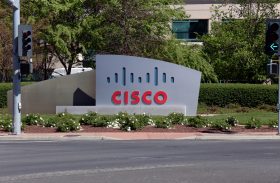Inside Cisco's FY 2022 Q1 Earnings Scare

Cisco has for many years kept a steady base of investors through its reputation as a blue chip “bellwether” of the technology industry. It has also succeeded in steadying profits, grown its dividend, and told a story about its strategic shift from hardware to annual recurring revenue (ARR) for software, which has become the holy grail in technology markets.
That may all be changing.
After a perplexing quarterly conference call that alternated between ebullience and paranoia and included many conflicting data points, Cisco investors sold the shares with abandon today – the stock was down 8% in mid-day trading, falling $4.55 to $52.22. Cisco shares are now 20% off their 52-week high, although they are still up about 20% year-to-date.
The key factors: Many questions emerged about Cisco’s move to raise prices across the board at least 10%, stoking fears about cost pressures and profit margins, as Cisco executives warned of lower margins in the future as a result of supply-chain disruptions. In addition, slower-than-expected growth in key areas such as security and software have cast doubt on Cisco’s narrative about a rapid transition to software and ARR sales.
Let’s run through the whole story.
Cost Pressure Scares Shareholders
So, what were the actual numbers? Cisco reported that quarterly revenue rose 8% to $12.9 billion, year-over-year (YoY). A year earlier, Cisco earnings were 76 cents a share on sales of $11.96 billion. Earnings also rose 8% to 82 cents a share from a year earlier. Analysts expected Cisco earnings of 81 cents a share on sales of $12.99 billion.
Cisco executives also tried to lean hard on the fact that product orders increased 33% from a year earlier.
However, what’s behind the order jump is key. Cisco has also announced that in response to supply-chain disruptions and the rising costs of raw materials, it’s raising prices. So the order flow might be a result of customers restocking before price hikes.
"The order book is getting pumped up by customers getting orders in ahead of Cisco's price increases," said Jefferies analyst George Notter in an analyst report.
Is that a good thing? If indeed Cisco customers are trying to get ahead of coming price inflation, that means the company is pulling demand forward and there could be less growth next year.
A larger concern was Cisco’s margins, which of course company executives blamed on an erratic supply chain. Cisco said that supply-chain issues are adding to rising cost, which is pressuring margins. Cisco reported gross margins of 64.5%, which was consistent with analyst expectations, but company officials warned about margin pressure in the future, which is probably a significant contributor to the stock falling. The company guided for gross margins in the range of 63.5% - 64.5% in the next quarter, below consensus for 64.8%.
What was interesting was the tone of the conference call, given the underlying concern and uncertainty.
Cisco executives, including CEO Chuck Robbins, did not seem concerned. They reported quarterly earnings with the usual swagger, imbued by Cisco’s deep sales and cheerleading culture.
Said Robbins:
“Moving into fiscal year ’22, we are off to a great start with robust order growth of 33%, and continued strong demand across our portfolio. Our teams are executing well, our ARR grew double-digits and our momentum is accelerating driven by digital transformation and cloud. Even with the ongoing supply constrained environment, we are solidly on track to deliver against our long-term financial targets by investing for growth, while delivering breakthrough innovation.
And then there’s this – full-on Cisco marketing overspeak:
“Our customers want digital and cloud-enabled solutions that allow them to move with greater speed, agility and efficiency.”
This may explain the cognitive dissonance between the numbers, the executive optimism, and the share price. Investors were clearly rattled. They are asking: Can Cisco really deliver on all its promises?
Business Divisions Mixed
When you drill down into Cisco’s new business divisions, the picture gets even murkier. This year, Cisco reorganized its business units into Secure, Agile Networks; Hybrid Work; End-to-End Security; Optimized Application Experiences; Internet for the Future; and Other Products.
Let's set aside for the moment that some of these business unit names are absurd and difficult to understand. In viewing the numbers, the businesses are incredibly inconsistent.
But we try to be fair and balanced. Let's' start with the positive.
The best growth came in Internet for the Future, which targets webscale datacenters and includes Cisco’s recently revamped Silicon One hardware architecture as well as its Acacia optical offerings. That division grew the most, by 46%, indicating that Cisco has this area right. It also makes sense given the recent earnings from Arista Networks, which show that webscale datacenters remain red hot.
Optimized Application Experiences, which includes Cisco's ThousandEyes monitoring and optimization acquisition, grew 18%. Again, to give Cisco credit, ThousandEyes, which Cisco bought in 2020 for about $1 billion, looks like a great acquisition. It's also a pure software play targeting the software-as-a-service (SaaS) market. Secure, Agile Networks grew 10%.
Source: Cisco
Then there are the less healthy areas. Hybrid Work, which includes Cisco’s Webex conferencing division, declined by 7%. And End-to-End Security, which includes Cisco's Duo Security zero-trust solution, grew only 4%. As we have pointed out here before, Cisco's security products and services are underperforming relative to peers in the midst of a booming cybersecurity market.
In fact, this exact same issue came up during the conference call Q&A, when Ittai Kidron from Oppenheimer pointed it out:
Hey, guys. Chuck, I want to focus on the security business, in fiscal ’19 you grew 18%. That was down to 12% in ’20, that was down to 7% to ’21 and you’re starting to hear at 4% here and now all in the same time your large competitors like Palo Alto and Fortinet and even Checkpoint for that matter are seeing accelerating growth, improving growth rates and growth rates in the teens 20s, that even 30s on a year-over-year basis. So maybe you can unpack this for me a little bit. I know you’ve been pleased with your Security business, but it seems like it’s kind of heading in the wrong direction growth wise relative to what the peers are doing.
Robbin's response was lukewarm, pointing to sold software subscription growth but also admitting that they had to do better. His response:
Ittai, it’s a great question. So first of all I will say that we have room to get better and secured and teams are working hard on that. There is a lot of innovative work going on, and then you called out the primary issue that Scott referenced in his opening comments is the on-prem sort of perpetual stuff in decline. And then the subscription-based businesses grew double-digits.
So what exactly is happening in software sales?
On the software evolution side, Cisco software business was 29% of sales, with 23% of revenue from subscription software. Total software revenue of $3.7 billion compares to $4.0 billion last quarter and $3.7 billion last year, which seems disappointing considering Cisco’s aggressive marketing message targeting the transition to software. The company’s ARR grew 10% y/y – Robbins’ “double digits,” which also seems light given the ARR growth in other parts of the industry.
I continue to think that the most difficult road that lies ahead for Cisco is the transformation of its business culture, which is arrogant and rooted in hardware sales. The numbers show that its software evolution is not quite living up to the hype. (Note: That is just this analyst's opinion.)
Wall Street Analysts May Be Surprised
Wall Street often follows the guidance of analysts' expectations. If the analysts are surprised, that's not good, and the stock will fall on the anticipation that they will lower forecasts.
Simon Leopold of Raymond James is still supporting Cisco stock with a price target of $64, but his reaction to the quarter was mixed:
We maintain our Outperform on Cisco following its F1Q22 mixed results. After hours, shares were down ~6%, which likely stems from a slight sales miss and lower January quarter outlook; however, an EPS beat and shockingly strong orders up to 33% y/y encourage us. Our sales estimates rise, but consensus will come down. We suspect some models underestimated supply chain constraints and over-estimated the tailwind from Cisco’s price increases. The combination of order strength and price increases contribute to our higher estimates that we still perceive as conservative. Our price target remains $64.
Another analyst, George Notter of Jefferies, felt "marginally worse," which doesn't sound that great:
Following last night’s EPS call, we feel marginally worse about Cisco’s ability to get components and deliver on full year results. Nonetheless, we think the business continues to grow on post-COVID recovery benefits and underlying strength from customers’ Digital Transformation efforts. We continue to see the risk/reward favorably and expect the multiple to expand as the mix of recurring sales increases.
Bottom line? Cisco has a lot of work to do in the next few quarters to regain investor confidence. It will need to reinforce growth in webscale datacenter, show that it can fix its security product growth problem, and prove that price hikes can stick and offset margin concerns.
(Disclosure: As a cloud technology research firm, Futuriom has many business relationships with Cisco competitors as well as customers. At the current time, Futuriom has no direct business relationship with Cisco.)

















